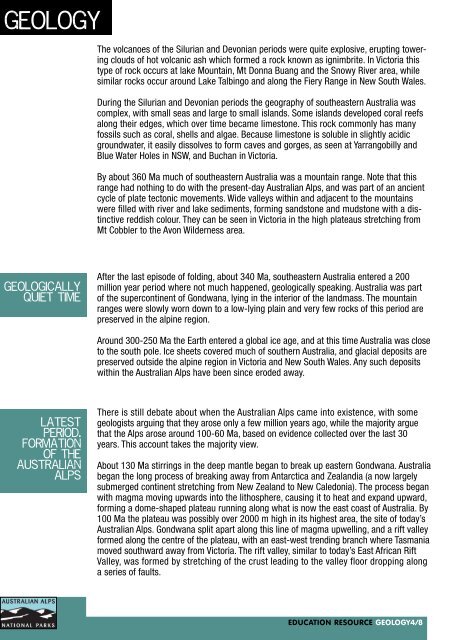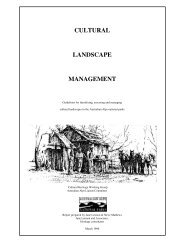Geology of the Australian Alps - Australian Alps National Parks
Geology of the Australian Alps - Australian Alps National Parks
Geology of the Australian Alps - Australian Alps National Parks
You also want an ePaper? Increase the reach of your titles
YUMPU automatically turns print PDFs into web optimized ePapers that Google loves.
geology<br />
The volcanoes <strong>of</strong> <strong>the</strong> Silurian and Devonian periods were quite explosive, erupting towering<br />
clouds <strong>of</strong> hot volcanic ash which formed a rock known as ignimbrite. In Victoria this<br />
type <strong>of</strong> rock occurs at lake Mountain, Mt Donna Buang and <strong>the</strong> Snowy River area, while<br />
similar rocks occur around Lake Talbingo and along <strong>the</strong> Fiery Range in New South Wales.<br />
During <strong>the</strong> Silurian and Devonian periods <strong>the</strong> geography <strong>of</strong> sou<strong>the</strong>astern Australia was<br />
complex, with small seas and large to small islands. Some islands developed coral reefs<br />
along <strong>the</strong>ir edges, which over time became limestone. This rock commonly has many<br />
fossils such as coral, shells and algae. Because limestone is soluble in slightly acidic<br />
groundwater, it easily dissolves to form caves and gorges, as seen at Yarrangobilly and<br />
Blue Water Holes in NSW, and Buchan in Victoria.<br />
By about 360 Ma much <strong>of</strong> sou<strong>the</strong>astern Australia was a mountain range. Note that this<br />
range had nothing to do with <strong>the</strong> present-day <strong>Australian</strong> <strong>Alps</strong>, and was part <strong>of</strong> an ancient<br />
cycle <strong>of</strong> plate tectonic movements. Wide valleys within and adjacent to <strong>the</strong> mountains<br />
were filled with river and lake sediments, forming sandstone and mudstone with a distinctive<br />
reddish colour. They can be seen in Victoria in <strong>the</strong> high plateaus stretching from<br />
Mt Cobbler to <strong>the</strong> Avon Wilderness area.<br />
geologically<br />
quiet time<br />
After <strong>the</strong> last episode <strong>of</strong> folding, about 340 Ma, sou<strong>the</strong>astern Australia entered a 200<br />
million year period where not much happened, geologically speaking. Australia was part<br />
<strong>of</strong> <strong>the</strong> supercontinent <strong>of</strong> Gondwana, lying in <strong>the</strong> interior <strong>of</strong> <strong>the</strong> landmass. The mountain<br />
ranges were slowly worn down to a low-lying plain and very few rocks <strong>of</strong> this period are<br />
preserved in <strong>the</strong> alpine region.<br />
Around 300-250 Ma <strong>the</strong> Earth entered a global ice age, and at this time Australia was close<br />
to <strong>the</strong> south pole. Ice sheets covered much <strong>of</strong> sou<strong>the</strong>rn Australia, and glacial deposits are<br />
preserved outside <strong>the</strong> alpine region in Victoria and New South Wales. Any such deposits<br />
within <strong>the</strong> <strong>Australian</strong> <strong>Alps</strong> have been since eroded away.<br />
latest<br />
period.<br />
formation<br />
<strong>of</strong> <strong>the</strong><br />
australian<br />
alps<br />
There is still debate about when <strong>the</strong> <strong>Australian</strong> <strong>Alps</strong> came into existence, with some<br />
geologists arguing that <strong>the</strong>y arose only a few million years ago, while <strong>the</strong> majority argue<br />
that <strong>the</strong> <strong>Alps</strong> arose around 100-60 Ma, based on evidence collected over <strong>the</strong> last 30<br />
years. This account takes <strong>the</strong> majority view.<br />
About 130 Ma stirrings in <strong>the</strong> deep mantle began to break up eastern Gondwana. Australia<br />
began <strong>the</strong> long process <strong>of</strong> breaking away from Antarctica and Zealandia (a now largely<br />
submerged continent stretching from New Zealand to New Caledonia). The process began<br />
with magma moving upwards into <strong>the</strong> lithosphere, causing it to heat and expand upward,<br />
forming a dome-shaped plateau running along what is now <strong>the</strong> east coast <strong>of</strong> Australia. By<br />
100 Ma <strong>the</strong> plateau was possibly over 2000 m high in its highest area, <strong>the</strong> site <strong>of</strong> today’s<br />
<strong>Australian</strong> <strong>Alps</strong>. Gondwana split apart along this line <strong>of</strong> magma upwelling, and a rift valley<br />
formed along <strong>the</strong> centre <strong>of</strong> <strong>the</strong> plateau, with an east-west trending branch where Tasmania<br />
moved southward away from Victoria. The rift valley, similar to today’s East African Rift<br />
Valley, was formed by stretching <strong>of</strong> <strong>the</strong> crust leading to <strong>the</strong> valley floor dropping along<br />
a series <strong>of</strong> faults.<br />
EDUCATION RESOURCE GEOLOGY4/8

















